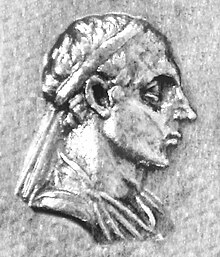Menander I
| Menander I | |
|---|---|
| Raja Yunani-India | |
 Gambar Menander I | |
| Berkuasa | 165/155–130 SM |
| Pendahulu | Antimachus II |
| Penerus | Strato I |
| Kelahiran | Kalasi, Iskandariyah di Kaukasus (kini Bagram, Afghanistan)[1][2] |
| Kematian | 130 SM |
| Pemakaman | Stupa di seluruh Kerajaan Yunani-India |
| Permaisuri | Agathokleia |
| Keturunan | Strato I |
| Wangsa | Wangsa Euthydemus |
| Agama | Buddhisme |
Menander I Soter (bahasa Yunani Kuno: Μένανδρος Α΄ ὁ Σωτήρ, Ménandros A' ho Sōtḗr, "Menander I Sang Penyelamat"; dikenal dalam sumber-sumber Pali India sebagai Milinda) adalah seorang Raja Yunani-India dari Kerajaan Yunani-India (165/[3]/155[3] –130 SM) yang mendirikan sebuah imperium besar di wilayah barat laut Asia Selatan dan menjadi pelindung Buddhisme.
Menander awalnya seorang raja Baktria. Setelah menaklukkan Punjab[2] dia mendirikan imperium di Asia Selatan yang membentang dari lembah Sungai Kabul di barat sampai Sungai Ravi di timur, dan dari lembah Sungai Swat di utara sampai ke Arachosia (Provinsi Helmand). Penulis India kuno menyatakan bahwa dia melancarkan ekspedisi ke arah selatan menuju Rajasthan dan sampai jauh ke timur menyusuri Lembah Sungai Gangga seperti Pataliputra (Patna), dan ahli geografi Yunani, Strabo menulis bahwa dia "menaklukkan lebih banyak suku bangsa daripada Aleksander Agung."
Catatan
[sunting | sunting sumber]- ^ "Menander". Encyclopædia Britannica Online. Encyclopædia Britannica, Inc. Diakses tanggal 8 September 2012.
- ^ a b Hazel, John (2013). Who's Who in the Greek World. Routledge. hlm. 155. ISBN 9781134802241.
Menander king in India, known locally as Milinda, born at a village named Kalasi near Alasanda (Alexandria-in-the-Caucasus), and who was himself the son of a king. After conquering the Punjab, where he made Sagala his capital, he made an expedition across northern India and visited Patna, the capital of the Mauraya empire, though he did not succeed in conquering this land as he appears to have been overtaken by wars on the north-west frontier with Eucratides.
- ^ a b Bopearachchi (1998) and (1991), respectively. The first date is estimated by Osmund Bopearachchi and R. C. Senior, the other Boperachchi
Referensi
[sunting | sunting sumber]- Monnaies Gréco-Bactriennes et Indo-Grecques, Catalogue Raisonné, Osmund Bopearachchi, 1991, Bibliothèque Nationale de France, ISBN 2-7177-1825-7.
- The Shape of Ancient Thought. Comparative studies in Greek and Indian Philosophies by Thomas McEvilley (Allworth Press and the School of Visual Arts, 2002) ISBN 1-58115-203-5
- Buddhism in Central Asia by B.N. Puri (Motilal Banarsidass Pub, January 1, 2000) ISBN 81-208-0372-8
- The Greeks in Bactria and India, W. W. Tarn, Cambridge University Press.
- Dictionary of Buddhism, Damien Keown, Oxford University Press ISBN 0-19-860560-9
- De l'Indus à l'Oxus, Archéologie de l'Asie Centrale, Osmund Bopearachchi, Christine Sachs, ISBN 2-9516679-2-2
- The Diffusion of Classical Art in Antiquity by John Boardman (Princeton University Press, 1994) ISBN 0-691-03680-2
- The Crossroads of Asia. Transformation in Image and symbol, 1992, ISBN 0-9518399-1-8
- Indo-Greek, Indo-Scythian and Indo-Parthian coins in the Smithsonian institution, Smithsonian Institution, Bopearachchi, 1993
